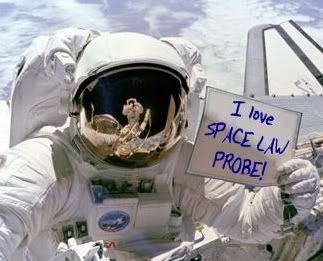1.31.2005
Space Station Forever?
This week Taylor Dinerman over at The Space Review asks what will surely be "one of the toughest questions for the next NASA administrator" -- What do we do with the ISS? And he concludes, "It is not enough just to commit to assembling the ISS to the full 2010 configuration: they will have to come up with a credible plan for what they hope to accomplish up there after it is built. Otherwise, the question arises: why finish it at all?"
1.27.2005
Hubble Trubble
Of course not Senator Barbara Mikulski (D-Md.), the space telescope's biggest Congressional guardian angel and cheerleader from the land of NASA Goddard, and her counterpart in the House, Congressman Steny Hoyer (D-MD).
Also pissed off are plenty of astronomers, educators and space enthusiasts everywhere, all awaiting the new budget, to be released on Feb 7. Meanwhile, Bruce Margon, associate director for science at the Space Telescope Science Institute, commented to New Scientist, "If they have already decided they are not going to touch Hubble, why aren't they sending stop-work orders to those contractors?"
Some say Hubble's loss is Mars' gain. But recall Rand Simberg's view that, "[w]hile its critics are lambasting the agency for sacrificing Hubble on the altar of the new space policy, the new policy in fact would actually justify a Hubble mission." (via Terrestrial Musings)
It may not be easy being Hubble. But in the end, it's always been worth it.
Apollo 1...1967 remembered
A Probe reader -- a lawyer, of course -- wrote in to ask if the widows received compensation. According to NASA, the widows of Virgil Grissom, Edward White, and Roger Chaffee did sue spacecraft manufacturer North American Rockwell for negligence. NASA records, "In 1972, out-of-court settlements to the three totaled $650,000." Recall the Apollo 1 tragedy, and early NASA glory, in Chariots for Apollo: A History of Manned Lunar Spacecraft.
1.26.2005
Tsunami Space
Here, NASA details some of the earthquake's effects on the home planet; and compiles space-eye views of the coasts devastated by Tsunami waters, as seen from Landsat-7, the Space Station, and other spaceborne instruments.
It seems so strange and unnatural. But it isn't. And we think Mars will be a hazardous and inhospitable place to live.
1.25.2005
Probe Book Picks
Let's get the year rolling right. What's on your space-related book list for 2005? Send me any recommendations and I'll happily add them to Spacelawstation's book showcase.
I finally picked up New Moon Rising: The Making of America's New Space Vision and the Remaking of NASA, by Frank Sietzen Jr. and Keith Cowing, covering the critical months in the life of the civil space program from the Columbia accident, February 1, 2003 to the release of the Presidential Commission report on Moon, Mars, and Beyond on June 2, 2004.. (By the way, in a recent Space.com interview, Frank said the book was "an unfinished story.")
I also want to fly though Delbert R. Terrill, Jr.'s The Air Force Role in Developing International Outer Space Law.
And for fun, and because Mars is the new moon, I traveled to Amazon for a copy of A Traveler's Guide to Mars: The Mysterious Landscapes of the Red Planet by William K. Hartmann.
So what are you reading (I mean when you're not hanging out here in blogspace)...?
1.06.2005
New Space Transport Policy is Official
(Compare the old policy released August 5, 1994).
The new policy, which was well in the works but then sidelined in the wake of the Columbia accident, contains no surprises. It maintains the status quo with respect to the two EELV (Atlas 5 and Delta 4) programs, as well as the requirement that U.S. payloads fly U.S. launch vehicles. The policy also requires NASA and DOD come up with a plan for development of heavy-lift launch vehicles. Policy wonks, dig in.






